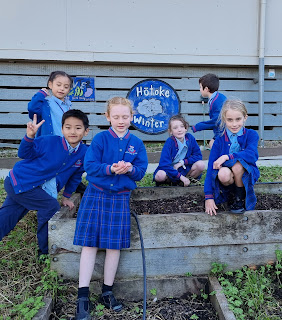The Eco Leaders grimly cleared our second kill from the rat trap today with Mrs Daniel. We don't like killing small furries but we do want to protect our native birds.
Tuesday, 20 June 2023
2023 Tree Planting Tally = 600
Last week Sunnyhills Eco Leaders planted 600 of their native tree seedlings we've grown, on Crabtree Organic Farm in Clevedon . Our efforts will extend the bird sanctuary there and protect the waterways. Thank you to Lynda & Trees For Survival.
Tuesday, 13 June 2023
Kawakawa 3 ways with Room Waru
Today we went into the nghere to look for kawakawa. - Cody Some kids ate the kawakawa leaves raw and they were a bit spicey. - Touma. The raw leaves tasted bitter. - Kyan. KawaKawa is a Maori herb. - Timmy. In Te Reo Maori it means a bitter plant. - Hunter. Kawakawa leaves are heart shaped. - Hana.
Next, we went to the kitchen and made kawkawa tea. The tea was quite nice for me and there was a hint of sweet from the honey. - Nathan. It was easy to make. Just put hot water on the leaves. - Touma.
Lastly we tried cooked kawakawa leaves. They tasted like weird wet lettuce. Cody
We found out that Kawakawa is important to Maori people. It's good for colds and infections. The orange berries are edible and sweet in summer.
After morning tea we investigated the history of tea. Here's some of what we found out:
China invented tea - Kyan
They started drinking it 6000 years ago - Marley
Queen CAtherine made it popular in England - Emma
The Dutch bought it to Europe from China using silver - Nathan
England stole tea plants from China and grew it in India - Luca
England started a war with China becasue they wanted to trade China opium for tea and the Emperor said no. - Orlando
Wednesday, 7 June 2023
Room 6 Explore Herbs & Spices
Herbs and spices add delicious aromas to our food and drinks. We explored some that we grow at school. So many different smells!!
Room Rima Investigating Herbal Tea
Today we investigated Aotearoa's own herbal tea - kawakawa. Fay - First we found kawakawa in the native bush walk. Janshly - Kawakawa likes to grow under other trees in the shade. Lucas F - The leaves look like lilly pads. Mrs Daniel picked the kawakawa leaves and we smelt them. Lucas F - they smelt like peppermint.
Bridie - Next we went to the kitchen so we could make the tea. Helena - Mrs Daniel put boiling water in the big tea pot. Daniel - I put the kawakawa leaves in the tea pot.
While the tea brewed we researched on our devices. Toby - Kawakawa grows in the South. Mavis - The common name is pepper. Lucas F - It's one of 3000 types of tea in the world.
We each got to drink the tea. Kayla - It tastes like tea mixed with honey. Toby - It tasted like smooth rice. Emily Z - It tasted like water. Janshly - It tastes like boiling water with honey. Mavis - The colour was like smooth honey.
Finally some of us tried the cooked kawakawa leaves. Emily W - They tasted like seaweed. Kaiden - It tasted like cooked seaweed that's wet. Kayla - The leaves looked like wet seaweed that grows in the sea.
After morning tea we learnt about the history of tea. Kayla - Tea started in China. Lucas F - The English stole tea from China. Emily - For a long time only China had tea.
Next time we see Mrs Daniel we will design our own herbal tea and tea pots.
Tuesday, 6 June 2023
Room 14's Sweet Lesson
Room 14 investigated how bees make hoeny today. We started our lesson by trying the honey and writing about it. Next we followed a Mystery Science online lesson and created a flow chart to show the steps bees take to make honey.
Lastly, we went to visit the native beehives and planted flower seeds to feed the bees.
Tekau ma Tahi Investigate Threats to our Mara Kai
Today Room 11 found out about pests that like to eat our crunchy cabbages in the mara kai. We saw holes in the cabbage leaves but the snails were hiding. We picked three cabbages and ate them.
Archer "It tasted plain. It was green."
Ruby "It kind of tastes oniony."
Sophia "WE ate the cabbage. We found the cabbage in the garden. It tastes like onion. I hate onion"
Mila "The cabbage tasted a bit peppery."
Azara "The cabbage smelled a bit weird but I still liked it".
Kacy "Today at enviro we were learning about growing cabbage. It tasted a bit peppery. I ate nine pieces. I love it!"
Kate "Today we ate some cabbage and I love it."
Leo "My cabbage didn't really have a smell."
Theo "The cabbages were yummy."
Kenny "I like to eat cabbages"
Valentin "We learnt how to plant some peas. They like to grow up sticks and string so Mrs Daniel put some stuff for the peas to grow.
We also spread compost and planted peas.
Next time we see Mrs Daniel we will see if our pea plants are growing.













































